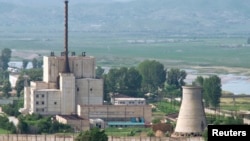Commercial satellite imagery suggests North Korea is just one or two months away from being able to restart a reactor that could produce plutonium critical to its nuclear weapons program.
The U.S.-Korea Institute at Johns Hopkins University says the images it released Monday show "significant progress" at the North's Yongbyon nuclear site, including work on a five-megawatt gas-graphite reactor.
The institute said the facility, once operational, could produce about six kilograms of plutonium per year that could be used in manufacturing nuclear weapons. That amount is believed to be enough to produce one or two bombs.
However, the report warned that a lack of fuel rods could delay such a plan.
David Straub with Stanford University's Korean Studies Program said the report is as accurate as possible without having experts on the ground.
"One of the difficulties is that the North Koreans are very good at deception, so we can't be completely sure of the status," he explained. "As [the analysts] themselves noted, there's some aspect of this, including work inside buildings, that of course they can't see and really can't estimate."
Pyongyang announced in April that it would restart operations at the Yongbyon reactor, which was shuttered in 2007 as part of its efforts to comply with a U.S.-backed denuclearization plan.
The U.S.-Korea Institute report also said North Korea is finishing interior work on a 20-30 megawatt experimental light-water reactor that could be operational in nine-12 months.
Leonid Petrov, a Korea analyst at the Australian National University, said Pyongyang will likely use the light-water reactor to advance its moribund economy.
"They need more electricity, they need to develop their peaceful nuclear program to produce more energy for its embattled economy which is still subject to numerous sanctions," he said.
The North has said the light-water reactor will generate electricity for civilian purposes. However, the U.S. is concerned it could also be used to make the weapons-grade plutonium that North Korea is believed to have used in past nuclear tests.
North Korea carried out a third nuclear test in February, in a move that set off weeks of heightened tensions between Pyongyang and its U.S.-backed neighbors. Tensions have since subsided, and the North has hinted that it is willing to restart international negotiations on its nuclear program.
Pyongyang is currently believed to have enough plutonium to make up to eight bombs. Analysts also suspect the North is making fuel for uranium bombs.
The U.S.-Korea Institute at Johns Hopkins University says the images it released Monday show "significant progress" at the North's Yongbyon nuclear site, including work on a five-megawatt gas-graphite reactor.
The institute said the facility, once operational, could produce about six kilograms of plutonium per year that could be used in manufacturing nuclear weapons. That amount is believed to be enough to produce one or two bombs.
However, the report warned that a lack of fuel rods could delay such a plan.
David Straub with Stanford University's Korean Studies Program said the report is as accurate as possible without having experts on the ground.
"One of the difficulties is that the North Koreans are very good at deception, so we can't be completely sure of the status," he explained. "As [the analysts] themselves noted, there's some aspect of this, including work inside buildings, that of course they can't see and really can't estimate."
North Korea's nuclear, missile program
North Korea's nuclear and missile programs- Aug. 1998: Test fires Taepodong-1, its first long-range rocket
- Sept. 1999: Pledges to freeze long-range missile tests amid improving U.S. ties
- Mar. 2005: Ends moratorium on missile tests, blames "hostile" policy of U.S.
- Jul. 5, 2006: Test fires long-range Taepodong-2, which fails after launch
- Jul. 15, 2006: U.N. Security Council demands Pyongyang halt missile program
- Oct. 9, 2006: Conducts first underground nuclear test
- Oct.15, 2006: U.N. Security Council demands halt to missile, nuclear tests, bans sale of weapons
- Apr. 5, 2009: Launches long-range rocket that lands in Pacific; U.S. says no satellite placed in orbit
- Apr. 13, 2009: U.N. Security Council condemns launch, tightens sanctions; Pyongyang quits six-party nuclear talks
- May 2009: Conducts second underground nuclear test
- Jun. 2009: Security Council imposes tougher sanctions
- Feb. 2012: Announces moratorium on nuclear and long-range missile programs in exchange for U.S. food aid
- Apr. 2012: Launches long-range rocket, which falls apart shortly after lift-off
- Dec. 2012: Launches Unha-3 rocket, declares success in placing satellite in orbit
- Jan. 2013: U.N. Security Council condemns December rocket launch
- Feb. 2013: Conducts third nuclear test
The U.S.-Korea Institute report also said North Korea is finishing interior work on a 20-30 megawatt experimental light-water reactor that could be operational in nine-12 months.
Leonid Petrov, a Korea analyst at the Australian National University, said Pyongyang will likely use the light-water reactor to advance its moribund economy.
"They need more electricity, they need to develop their peaceful nuclear program to produce more energy for its embattled economy which is still subject to numerous sanctions," he said.
The North has said the light-water reactor will generate electricity for civilian purposes. However, the U.S. is concerned it could also be used to make the weapons-grade plutonium that North Korea is believed to have used in past nuclear tests.
North Korea carried out a third nuclear test in February, in a move that set off weeks of heightened tensions between Pyongyang and its U.S.-backed neighbors. Tensions have since subsided, and the North has hinted that it is willing to restart international negotiations on its nuclear program.
Pyongyang is currently believed to have enough plutonium to make up to eight bombs. Analysts also suspect the North is making fuel for uranium bombs.









